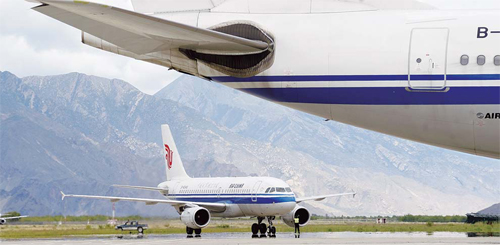Economy
Tibet Airlines to start routes to Europe
By Liu Jie and Lu Haoting (China Daily)
Updated: 2010-08-25 08:05
 |
Large Medium Small |
LHASA - Tibet Airlines is planning to launch routes to Europe within five years and expand its fleet to 50 by 2020.
 An aircraft is inspected at Gonggar Airport, Lhasa. Tibet Airlines, which will make its maiden flight next August, is based at the airport. [Xinhua] |
Liu Yanping, general manager of the State-owned airline, told China Daily that the carrier plans to build Lhasa Gonggar Airport, where it is based, "into an aviation center that not only links various parts of the autonomous region but also Tibet and other areas".
|
||||
The carrier is a 280-million-yuan ($41 million) joint venture between Tibet Autonomous Region Investment Co Ltd, holding a 51 percent stake, and Tibet Sanli Investment and Tibet Ruiyi Investment, owning 39 and 10 percent stakes.
It will make its maiden flight next August, when three Airbus A319s ordered this month arrive. "We plan to have 20 aircraft by 2015," Liu said.
As the first Tibet-based carrier, the airline plans to have routes serving the autonomous region and key cities across the nation by 2012.
Flights to South Asia and Southeast Asia are expected by 2013.
"We hope to have direct routes to European nations in 2015 or 2016," said Liu, who has worked in the civil aviation industry for 25 years and used to be employed by Air China's southwestern branch.
"We will help relieve long-existing transport capacity pressures in Tibet, said Liu. He added that the problems presented by slack off-season demand "will be resolved with the development of Tibet's tourism industry".
So far, six airlines operate 16 routes in Tibet, according to the Civil Aviation Administration of China.
Air China has a more than 50 percent market share, followed by Sichuan Airlines with 30 percent. The balance is shared between China Southern, China Eastern, Shenzhen Airlines and Hainan Airlines.
The autonomous region has five airports in Lhasa, Qamdo, Nyingchi, Ngari and Xigaze. A new one is under construction in Nagqu.
"In the peak season, normally from June to October, nearly all flights are full. Local airports' passenger handling capacity has increased at a double-digit rate annually on average, highlighting the industry's huge growth potential," said Wu Yunying, an aviation industry analyst at Changjiang Securities.
Last year 5.61 million tourists visited Tibet and the region earned 5.6 billion yuan in tourism revenue, both up nearly 150 percent year-on-year, according to the local tourism administration.
"Actually, the gap between the peak season and off-season is narrowing. We are cooperating with Tibet Tourism Administration to develop off-season travel products to further promote travel between the end of October and June," said Liu.
The profit margin of flights to Tibet is bigger than other areas. The operational cost of a high-plateau flight is about between 50,000 yuan and 60,000 yuan per hour. But the ticket price for high-altitude flights is double that in other areas with a comparable distance.



